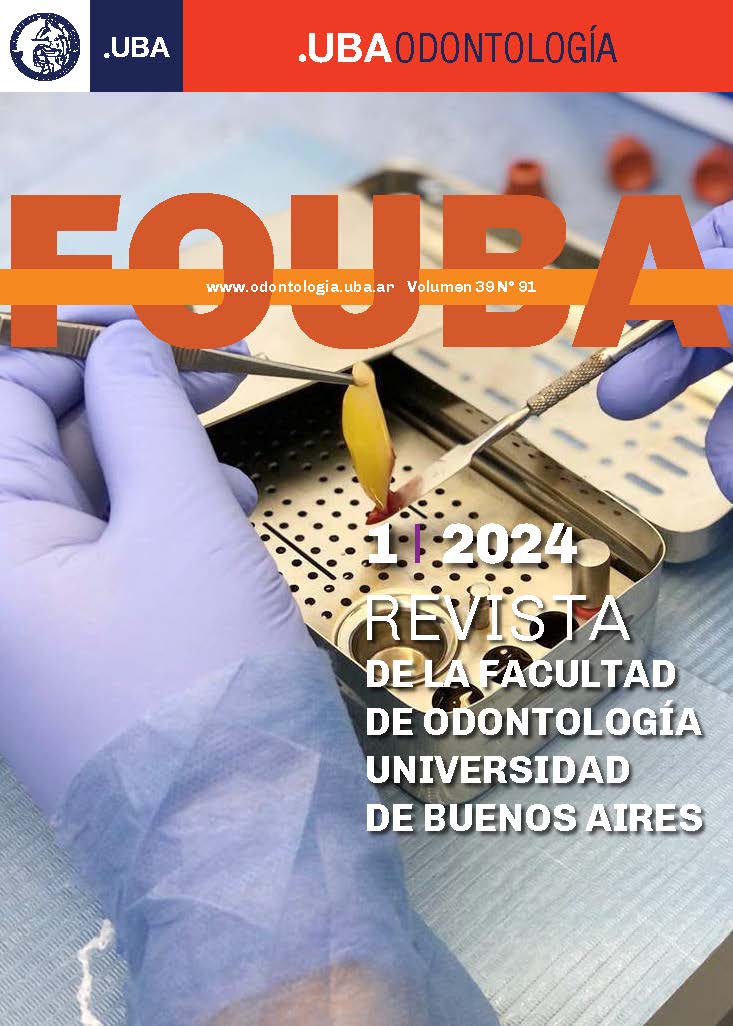Frecuencia y Tipología del Segundo Conducto Mesiovestibular en Primeros Molares Superiores
DOI:
https://doi.org/10.62172/revfouba.n91.a197Palabras clave:
Endodoncia, Molares superiores, Raíz Mesiovestibular, MorfologíaResumen
Objetivos: Evaluar mediante microscopia quirúrgica la presencia del segundo conducto mesiovestibular (MV2) en el piso de la cámara pulpar de los primeros molares superiores, determinar su abordabilidad, establecer el calibre de lima que llegó al tercio apical y tipificar radiovisiográficamente su morfología según la clasificación de Weine. Materiales y métodos: Se utilizaron 48 primeros molares superiores humanos extraídos. Sé tomaron radiovisografías preoperatorias (Carestream 5200) en sentido orto radial y mesio-distal. Se realizó apertura y se localizó entrada del MV2 con microscopio quirúrgico (Newton MEC XXI, Argentina) a 16 x. Se cateterizó MV1 y MV2 con limas tipo K #10 y #15 (Dentsply Maillefer). Se cortó raíz distovestibular para mejorar visualización radiovisográfica. Se tomó conductometria en sentido mesio-distal para establecer la tipología. Se compararon frecuencias y porcentajes mediante test de Chi-cuadrado con corrección de Yates, prueba exacta de Fisher y test z para diferencia de proporciones. Se calcularon intervalos de confianza 95% para porcentajes mediante método score de Wilson. Resultados: El 54% (26 casos) presentó MV2. De los 26 MV2, el 77% (20 casos) fueron abordables, porcentaje significativamente mayor al 23% no abordable (z=3,62; P<0,05). Al hacer cateterismo, hubo asociación significativa entre tipo de conducto (MV1 y MV2) y calibre de lima que llegó al tercio apical (Chi-cuadrado=29,12; gl=1; P<0,05). La tipología I (58%) fue significativamente mayor que las tipologías II (21%) y III (21%) (P<0,05 para ambas comparaciones). Conclusión: El alto porcentaje de piezas que presentó MV2 evidencia la importancia clínica de detectarlo y tratarlo correctamente. Dado el alto porcentaje de piezas donde fue abordable, se concluye que el clínico debe tener conocimiento, destreza y la tecnología necesaria para poder abordarlo. Si bien la tipología I (58%) fue la más encontrada, cuando el MV2 termina en foramen independiente (tipo III), su omisión puede conducir al fracaso del tratamiento.
Citas
Alavi, A. M., Opasanon, A., Ng, Y. L., y Gulabivala, K. (2002). Root and canal morphology of Thai maxillary molars. International Endodontic Journal, 35(5), 478–485. https://doi.org/10.1046/j.1365-2591.2002.00511.x
Al-Saedi, A., Al-Bakhakh, B., y Al-Taee, R. G. (2020). Using Cone-Beam Computed Tomography to determine the prevalence of the second mesiobuccal canal in maxillary first molar teeth in a sample of an Iraqi population. Clinical, Cosmetic and Investigational Dentistry, 12, 505–514. https://doi.org/10.2147/CCIDE.S281159
Al-Shehri, S., Al-Nazhan, S., Shoukry, S., Al-Shwaimi, E., Al-Sadhan, R., y Al-Shemmery, B. (2017). Root and canal configuration of the maxillary first molar in a Saudi subpopulation: a cone-beam computed tomography study. Saudi Endodontic Journal, 7(2), 69–76. https://journals.lww.com/senj/fulltext/2017/07020/root_and_canal_configuration_of_the_maxillary.1.aspx
Blattner, T. C., George, N., Lee, C. C., Kumar, V., y Yelton, C. D. (2010). Efficacy of cone-beam computed tomography as a modality to accurately identify the presence of second mesiobuccal canals in maxillary first and second molars: a pilot study. Journal of Endodontics, 36(5), 867–870. https://doi.org/10.1016/j.joen.2009.12.023
Buhrley, L. J., Barrows, M. J., BeGole, E. A., y Wenckus, C. S. (2002). Effect of magnification on locating the MB2 canal in maxillary molars. Journal of Endodontics, 28(4), 324–327. https://doi.org/10.1097/00004770-200204000-00016
Campos Netto, P. A.; Lins, C. C. S. A.; Lins, C. V.; Lima, G. A., y Frazão, M. A. G. (2011). Study of the internal morphology of the mesiobuccal root of upper first permanent molar using cone beam computed tomography. International Journal of Morphology, 29(2), 617-621. https://doi.org/10.4067/S0717-95022011000200053
Cleghorn, B. M., Christie, W. H., y Dong, C. C. (2006). Root and root canal morphology of the human permanent maxillary first molar: a literature review. Journal of Endodontics, 32(9), 813–821. https://doi.org/10.1016/j.joen.2006.04.014
Das, S., Warhadpande, M. M., Redij, S. A., Jibhkate, N. G., y Sabir, H. (2015). Frequency of second mesiobuccal canal in permanent maxillary first molars using the operating microscope and selective dentin removal: A clinical study. Contemporary Clinical Dentistry, 6(1), 74–78. https://doi.org/10.4103/0976-237X.149296
Degerness, R. A., y Bowles, W. R. (2010). Dimension, anatomy and morphology of the mesiobuccal root canal system in maxillary molars. Journal of Endodontics, 36(6), 985–989. https://doi.org/10.1016/j.joen.2010.02.017
Görduysus, M. O., Görduysus, M., y Friedman, S. (2001). Operating microscope improves negotiation of second mesiobuccal canals in maxillary molars. Journal of Endodontics, 27(11), 683–686. https://doi.org/10.1097/00004770-200111000-00008
Hasan, M., y Raza Khan, F. (2014). Determination of frequency of the second mesiobuccal canal in the permanent maxillary first molar teeth with magnification loupes (× 3.5). International Journal of Biomedical Science : IJBS, 10(3), 201–207. https://www.ncbi.nlm.nih.gov/pmc/articles/pmid/25324702/
Hess, W., y Zurcher, E. (1925). The anatomy of the root canals of the teeth of the permanent and deciduous dentitions. William Wood & Co.
Hilú, R., Tula, C., Pérez, A., y Vietto, L. (2011). Estudio de la anatomía interna de la raíz mesiovestibular de los primeros molares superiores. Revista de la Asociación Odontológica Argentina, 99(4), 273–280. https://raoa.aoa.org.ar/revistas/?roi=994000291
Magat, G., y Hakbilen, S. (2019). Prevalence of second canal in the mesiobuccal root of permanent maxillary molars from a Turkish subpopulation: a cone-beam computed tomography study. Folia Morphologica, 78(2), 351–358. https://doi.org/10.5603/FM.a2018.0092
Mittal, N., y Arora, S. (2015). Role of microendodontics in detection of root canal orifices: a comparative study between naked eye, loupes and surgical operating microscope. Journal of Medical Science and Clinical Research, 3(10), 7810–7816. http://doi.org/10.18535/jmscr/v3i10.17
Moidu, N. P., Sharma, S., Kumar, V., Chawla, A., y Logani, A. (2021). Association between the mesiobuccal canal configuration, interorifice distance, and the corresponding root length of permanent maxillary first molar tooth: a cone-beam computed tomographic study. Journal of Endodontics, 47(1), 39–43. https://doi.org/10.1016/j.joen.2020.08.025
Sempira, H. N., y Hartwell, G. R. (2000). Frequency of second mesiobuccal canals in maxillary molars as determined by use of an operating microscope: a clinical study. Journal of Endodontics, 26(11), 673–674. https://doi.org/10.1097/00004770-200011000-00010
Sert, S., y Bayirli, G. S. (2004). Evaluation of the root canal configurations of the mandibular and maxillary permanent teeth by gender in the Turkish population. Journal of Endodontics, 30(6), 391–398. https://doi.org/10.1097/00004770-200406000-00004
Su, C. C., Wu, Y. C., Chung, M. P., Huang, R. Y., Cheng, W. C., Cathy Tsai, Y. W., Hsieh, C. Y., Chiang, H. S., Chen, C. Y., y Shieh, Y. S. (2017). Geometric features of second mesiobuccal canal in permanent maxillary first molars: a cone-beam computed tomography study. Journal of Dental Sciences, 12(3), 241–248. https://doi.org/10.1016/j.jds.2017.03.002
Verma, P., y Love, R. M. (2011). A Micro CT study of the mesiobuccal root canal morphology of the maxillary first molar tooth. International Endodontic Journal, 44(3), 210–217. https://doi.org/10.1111/j.1365-2591.2010.01800.x
Weine, F. S., Healey, H. J., Gerstein, H., y Evanson, L. (1969). Canal configuration in the mesiobuccal root of the maxillary first molar and its endodontic significance. Oral Surgery, Oral Medicine, and Oral Pathology, 28(3), 419–425. https://doi.org/10.1016/0030-4220(69)90237-0
Publicado
Cómo citar
Número
Sección
Licencia
Derechos de autor 2024 Revista de la Facultad de Odontologia de la Universidad de Buenos Aires

Esta obra está bajo una licencia internacional Creative Commons Atribución-NoComercial-SinDerivadas 4.0.











